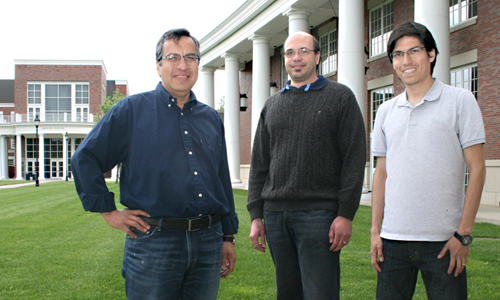
Dr. Sergio Ulloa, Dr. Diego Mastroguiseppe, and Doctoral Student Oscar Avalos
By Jean Andrews
Physics & Astronomy
Oscar Avalos, doctoral student in Physics & Astronomy, Visiting Researcher Diego Mastrogiuseppe, and Dr. Sergio Ulloa, Professor of Physics at Ohio University, report discovering unusually long-reaching spintronic interactions at the atomic level in a newly published article.
It is likely that future electronic devices and transistors—”consumer spintronics”—will make use of the strong spin-orbit effects such as the ones described in their paper.
Their article—Noncollinear exchange interaction in transition metal dichalcogenide edges—is published in Physical Review B, a condensed matter and materials physics journal of the American Physical Society. The APS designated the researchers’ discovery as meriting a Rapid Communication, placing it ahead of articles similar in subject matter. Avalos is the lead author of the article.
The APS reviewers believed that the topic studied would be very interesting to both experimentalists and theorists interested in two-dimensional nanoscale crystals—for which there is a great deal of activity in physics and engineering.
“Interest is growing in these novel materials with unique properties,” says Avalos. “They are likely to lead to new concepts and experiments with possible spintronics applications. Today’s applications and technologies are the combination of experiments and theory that were considered novel 20 years ago.”
Spintronics is an emerging field of nanoscale electronics involving the detection and manipulation of electronic spin, which replaces the use of electrical charges in communication and other electronic devices.
Manipulating Nanoflake Deposits
The article describes how two magnetic atoms/impurities interact when they are deposited on or near the edges of nanoflakes made of a new kind of material, called transition metal dichalcogenide trilayers. These TMD trilayers can be seen as constructed by stacking atomic layers of different materials, such as S-Mo-S (sulphur-molybdenum-sulphur) to make molybdenum disulphide (MoS2), among others.
Most ideas on spintronic effects arise from the interaction of the electron spin with magnetic materials. In the materials the researchers study, the manipulation of the spins comes from the large spin-orbit coupling coming from the TMDs. This would make it possible to control spins by electric fields (voltages), which are much more practical, portable, and faster than strong electromagnets.
Apart from the remarkable atomic trilayer structure of these TMDs over a large area, the electrons in them have unusual properties where the motion and the spin of the electron is univocally linked to one another.
“We’re excited about these findings,” Ulloa explains. “Not only for the unusual spiraling structures we anticipate, but because they could be readily measured by experimental techniques such as the spin-polarized scanning tunneling microscopes in the laboratories of Dr. Saw-Wai Hla and Dr. Arthur Smith in our department.”
The researchers find that the interaction between impurities in these materials is also unusual: stronger when the impurities sit on the edge of the flake than when they sit anywhere else, and—most importantly—they interact to create complex spiraling structures of their magnetic moments, when several of the impurities are lined on the flake. They also find that one can tailor and manipulate this alignment by varying real experimental parameters.
Exploiting the Spin of the Electron
Most current electronic devices exploit the “charge” nature of the electrons for functioning, but there is another feature of them that is still mostly unexploited: The spin of the electron.
The spin can be seen as the magnetic moment of the electron—an intrinsic little magnet that points in one of two directions, up or down—and can be manipulated by aligning it with a magnetic field, as those in the vicinity of magnets. One can also align electronic spins by controlling the interaction with their own motion—the spin-orbit coupling, which is very large in TMDs.
There are already prototype electronic devices and transistors made on TMDs, and the field is advancing rapidly. It is likely that future devices will make use of the strong spin-orbit effects such as the ones described in the paper.
Most ideas on spintronic effects arise from the interaction of the electron spin with magnetic materials, however. In the materials they study, the manipulation of the spins comes from the large spin-orbit coupling coming from the TMDs. This would make it possible to control spins by electric fields (voltages), which are much more practical, portable, and faster than strong electromagnets.
Controlling the Spin and Further Studies
The manipulation and delicate control of the spin is becoming a new branch of technological development, which is likely to find its way to consumer spintronics in the near future. Spintronics will eventually allow building devices with higher processing speed and higher energy efficiency, as charge would not have to be moved around, reducing significantly the generation of heat. More experiments and theoretical ideas would be needed to have a complete understanding of the possibilities of these and related materials.
This is work is a natural extension of previous work by Mastrogiuseppe, Dr. Nancy Sandler, and Ulloa. While that studied the interaction of impurities on large area crystals, the current work focuses on the non-trivial role of edges of these flakes, as those produced in the lab.
Avalos is extending his studies to consider different kinds of TMDs structures.
“I’d like to turn my attention to lateral heterostructures recently achieved experimentally, where two different materials are ‘stitched’ together at a line,” he says. “I’m studying the electronic properties of these structures so that I can later investigate how magnetic atoms/impurities will interact in these novel systems.”



















Comments